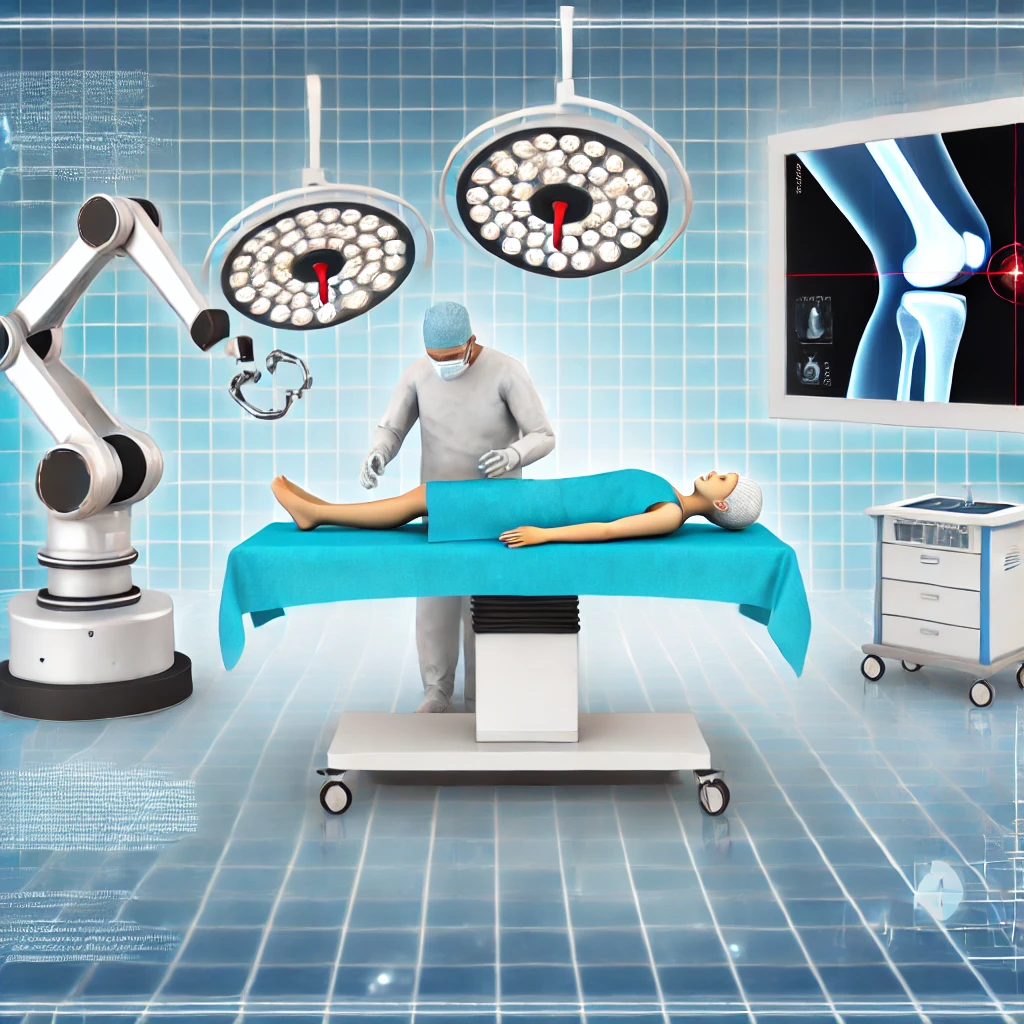
Joint replacement surgeries have come a long way since their inception, offering relief and improved mobility to countless individuals suffering from severe joint pain and dysfunction. In recent years, robotic-assisted joint replacement surgeries have emerged as a groundbreaking advancement in the field. These innovative techniques promise greater precision, reduced recovery times and improved patient outcomes. Let’s explore the advancements in robotic-assisted joint replacement surgeries and how they are revolutionizing patient care.
History of Joint Replacement Surgery
Early Techniques and Technologies
Joint replacement surgery, also known as arthroplasty, dates back to the early 20th century. Initial techniques were rudimentary, focusing primarily on pain relief rather than restoring full function. Over the decades, advancements in materials, surgical techniques and technology have transformed joint replacement into a highly effective procedure.
Evolution to Modern Practices
Modern joint replacement surgeries employ advanced materials like titanium and polyethylene, along with sophisticated surgical techniques. These developments have significantly improved the longevity and functionality of artificial joints.
What is Robotic-Assisted Joint Replacement Surgery?
Definition and Key Components
Robotic-assisted joint replacement surgery involves the use of robotic systems to aid surgeons in performing precise and accurate joint replacements. These systems include robotic arms, 3D imaging and computer-assisted planning tools.
How It Differs from Traditional Surgery
Unlike traditional surgery, where the surgeon relies solely on their skill and experience, robotic-assisted surgery provides enhanced precision and control. The robotic system assists in making accurate bone cuts and positioning the implant, reducing the margin for error.
Types of Robotic Systems Used
MAKO
The MAKO system, developed by Stryker, is widely used for knee and hip replacements. It combines 3D imaging and robotic assistance to enhance surgical precision.
NAVIO
NAVIO, developed by Smith & Nephew, offers a robotic-assisted platform for partial and total knee replacements. It uses advanced software for precise implant placement.
ROSA
The ROSA (Robotic Surgical Assistant) system by Zimmer Biomet is designed for knee and hip replacements. It features real-time data and imaging to assist surgeons during the procedure.
How Robotic-Assisted Surgery Works
Preoperative Planning
Before the surgery, detailed 3D images of the patient’s joint are created using CT or MRI scans. These images help in planning the surgery with high precision, determining the exact size and positioning of the implant.
Intraoperative Precision
During the surgery, the robotic system provides real-time feedback and guidance to the surgeon. The robotic arm assists in making precise bone cuts and accurately positioning the implant, ensuring optimal alignment and fit.
Postoperative Outcomes
Robotic-assisted surgery often results in better postoperative outcomes, including reduced pain, faster recovery, and improved joint function. The precision of the robotic system minimizes the risk of complications and enhances the longevity of the implant.
Benefits of Robotic-Assisted Surgery
Increased Accuracy and Precision
Robotic systems enhance the surgeon’s ability to perform precise bone cuts and implant positioning, leading to better alignment and joint function.
Reduced Recovery Time
Patients undergoing robotic-assisted surgery often experience shorter hospital stays and faster recovery times due to the minimally invasive nature of the procedure.
Improved Patient Outcomes
Enhanced precision and reduced trauma to the surrounding tissues result in lower complication rates and better long-term outcomes for patients.
Challenges and Limitations
Technical Challenges
Robotic-assisted surgery requires advanced technology and infrastructure, which may not be available in all medical facilities. The complexity of the systems also demands extensive training for surgeons.
Cost Considerations
The cost of robotic systems and the associated training can be high, potentially increasing the overall cost of the surgery. However, the long-term benefits may outweigh the initial expenses.
Training and Skill Requirements
Surgeons need specialized training to operate robotic systems effectively. Continuous education and practice are essential to maintain proficiency and ensure optimal outcomes.
Case Studies and Success Rates
Notable Case Studies
Several case studies have highlighted the success of robotic-assisted joint replacement surgeries. For example, a study at a leading orthopedic center reported significantly improved outcomes for patients undergoing robotic-assisted knee replacements compared to traditional methods.
Statistical Success Rates
Research indicates that robotic-assisted surgeries have higher success rates, with reduced revision rates and improved implant longevity. Patients also report higher satisfaction levels due to better joint function and reduced pain.
Patient Experience and Satisfaction
Testimonials and Reviews
Many patients have shared positive experiences with robotic-assisted surgeries. Testimonials often highlight the reduced pain, quicker recovery, and improved mobility they experienced post-surgery.
Comparative Satisfaction Rates
Studies comparing traditional and robotic-assisted surgeries show higher satisfaction rates among patients who underwent robotic-assisted procedures. The precision and minimally invasive nature of the surgery contribute to these positive outcomes.
Future Trends in Robotic-Assisted Surgery
Emerging Technologies
The field of robotic-assisted surgery is continuously evolving, with new technologies and systems being developed. Innovations like augmented reality and artificial intelligence are expected to further enhance surgical precision and outcomes.
Potential Future Applications
Robotic-assisted techniques are expanding beyond joint replacements to other surgical fields, including spinal surgery, neurosurgery, and general surgery. The potential applications of these technologies are vast and promising.
Comparing Traditional and Robotic-Assisted Surgeries
Pros and Cons of Each Method
Traditional surgery has a long track record and is widely accessible, but it relies heavily on the surgeon’s skill and experience. Robotic-assisted surgery offers enhanced precision and outcomes but requires specialized equipment and training.
Decision-Making Factors for Patients
Patients should consider various factors, including the surgeon’s experience, the availability of robotic systems and personal preferences when deciding between traditional and robotic-assisted surgery.
Cost and Insurance Considerations
Cost Comparison
Robotic-assisted surgeries can be more expensive due to the cost of the robotic systems and training. However, the reduced recovery time and improved outcomes may justify the higher initial cost.
Insurance Coverage and Reimbursement
Insurance coverage for robotic-assisted surgeries varies. Patients should check with their insurance providers to understand the coverage options and potential out-of-pocket costs.
Preparing for Robotic-Assisted Surgery
Preoperative Steps and Planning
Preparation for robotic-assisted surgery includes thorough medical evaluations, imaging studies and consultations with the surgical team. Patients should follow preoperative instructions to ensure optimal outcomes.
Choosing the Right Surgeon and Facility
Selecting an experienced surgeon and a facility equipped with advanced robotic systems is crucial for successful outcomes. Patients should research and seek recommendations to make informed decisions.
Postoperative Care and Rehabilitation
Recovery Timeline
Recovery from robotic-assisted surgery is often faster than traditional surgery. Patients can expect to resume normal activities sooner, although the exact timeline varies depending on the individual and the specific procedure.
Rehabilitation Best Practices
Effective rehabilitation is essential for optimal recovery. Physical therapy, regular follow-up appointments, and adherence to postoperative instructions play a vital role in restoring joint function and mobility.
Conclusion
Robotic-assisted joint replacement surgeries represent a significant advancement in orthopedic care. These innovative techniques offer enhanced precision, reduced recovery times and improved patient outcomes, making them a valuable option for individuals suffering from severe joint pain and dysfunction. As technology continues to evolve, the future of robotic-assisted surgery looks promising, with potential applications extending beyond joint replacements to other surgical fields. If you are considering joint replacement surgery, exploring robotic-assisted options may provide you with the benefits of advanced precision and improved recovery.
FAQs
Is robotic-assisted surgery safe?
Yes, robotic-assisted surgery is considered safe and offers enhanced precision and outcomes compared to traditional surgery.
How long is the recovery period for robotic-assisted joint replacement?
Recovery times vary, but patients often experience faster recovery compared to traditional surgery, with many resuming normal activities within a few weeks.
Are there any risks associated with robotic-assisted surgery?
As with any surgery, there are risks, but robotic-assisted surgery generally has a lower risk of complications due to its precision and minimally invasive nature.
Is robotic-assisted surgery covered by insurance?
Coverage varies by insurance provider and policy. Patients should check with their insurance company to understand coverage options and potential costs.
How do I choose the right surgeon for robotic-assisted surgery?
Look for a surgeon with specialized training and experience in robotic-assisted surgery. Research their credentials and seek recommendations from trusted sources.



